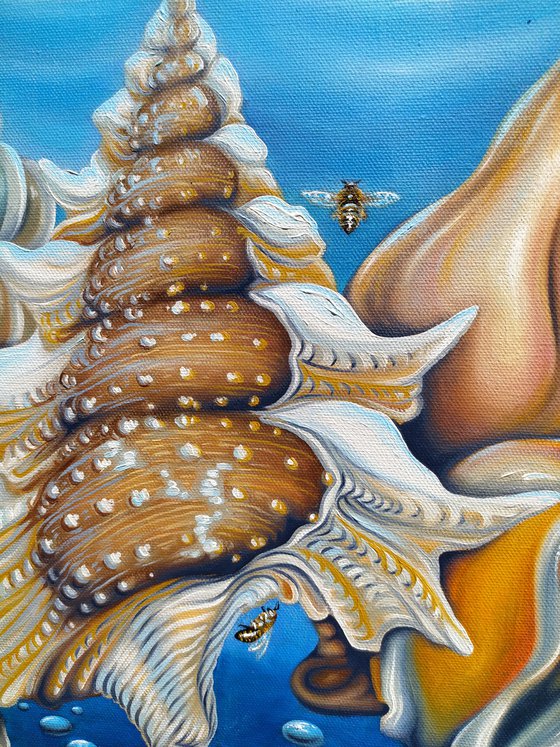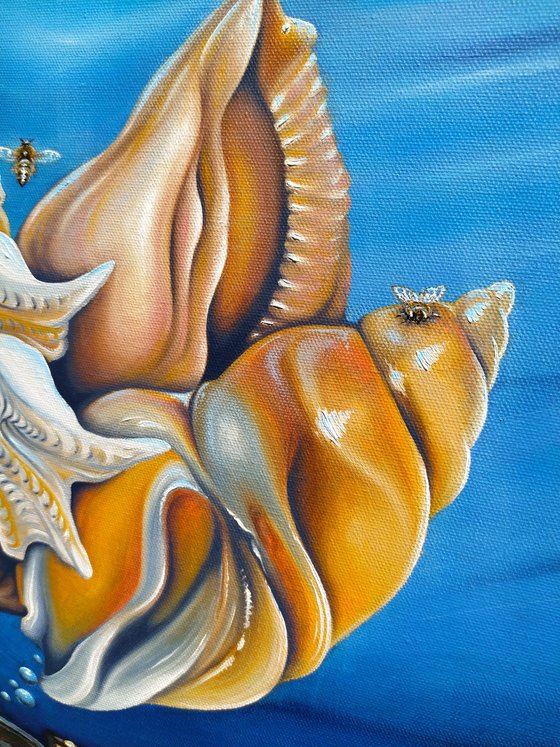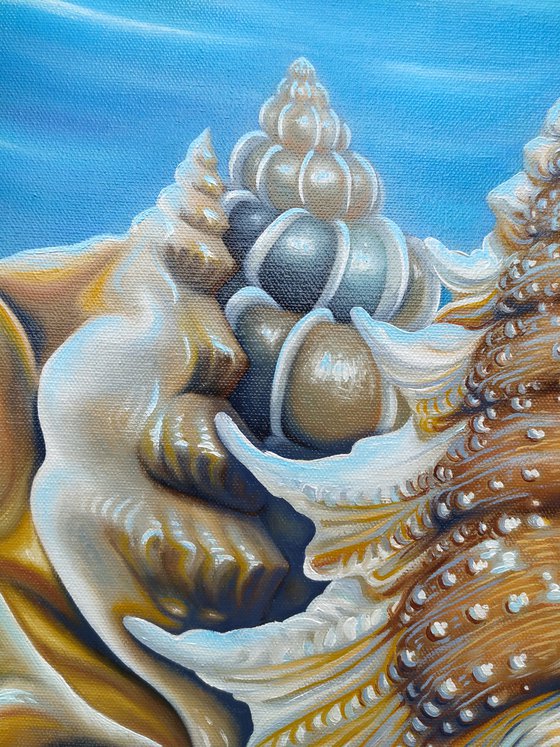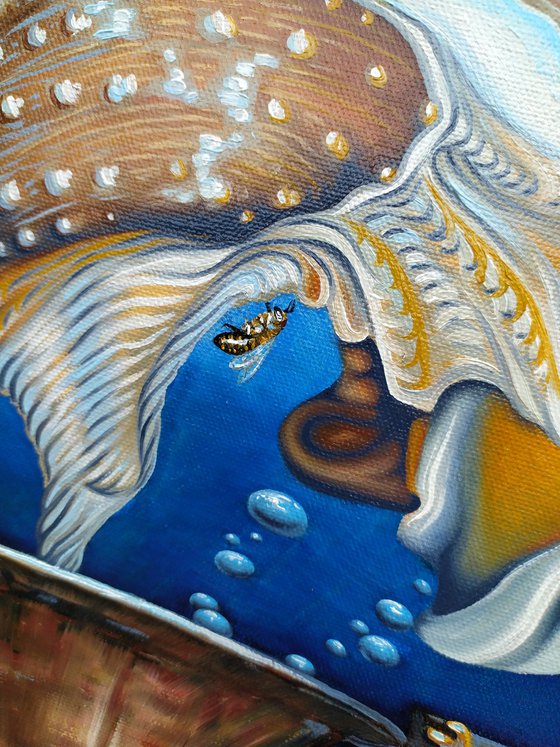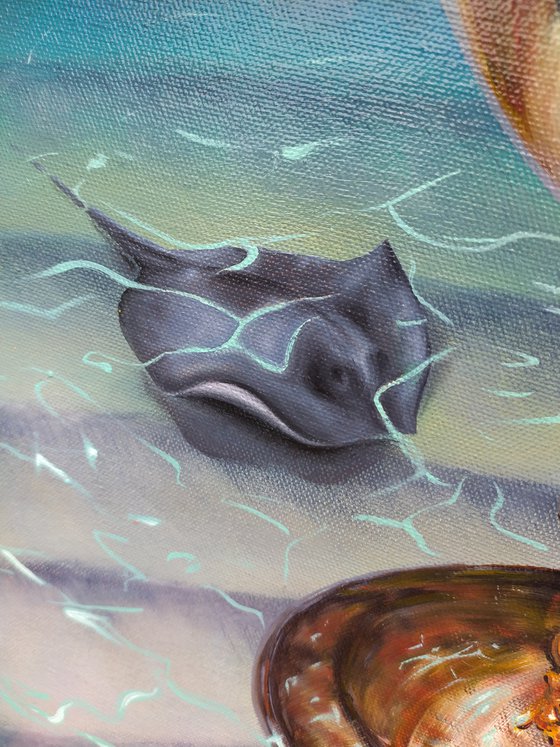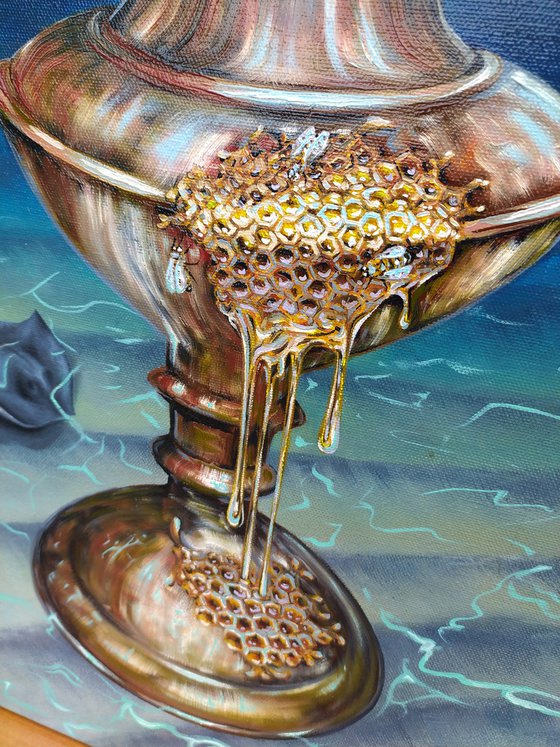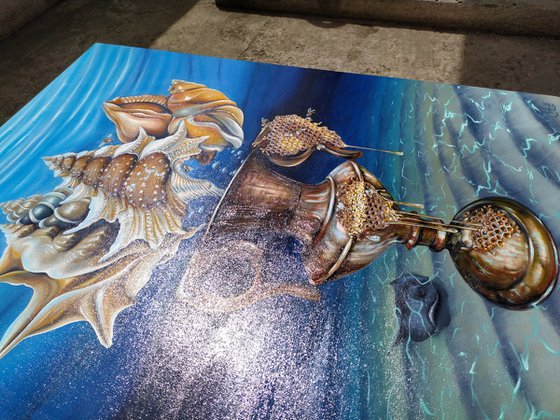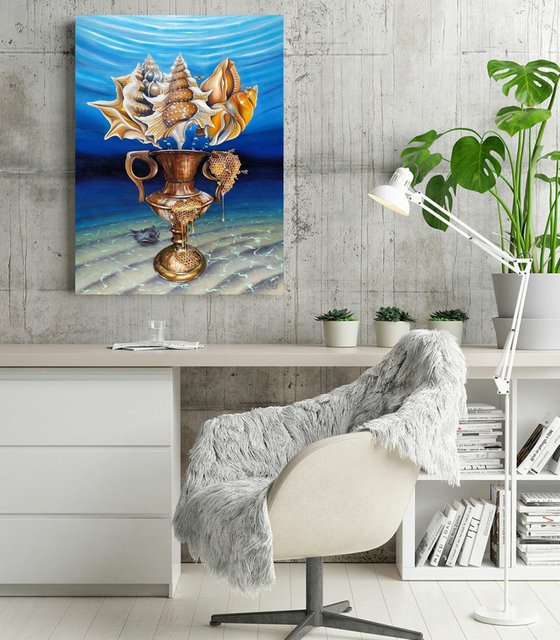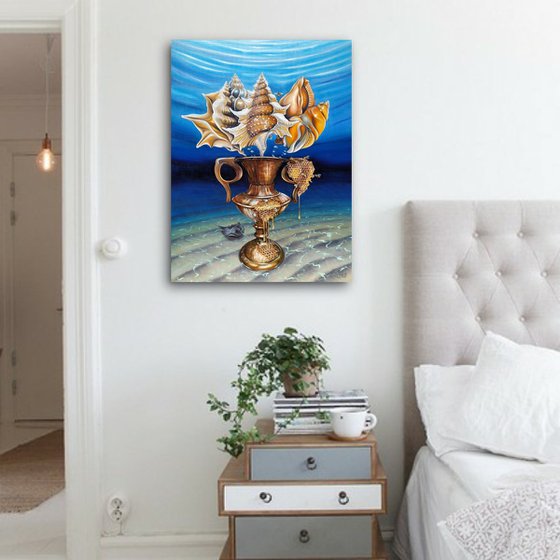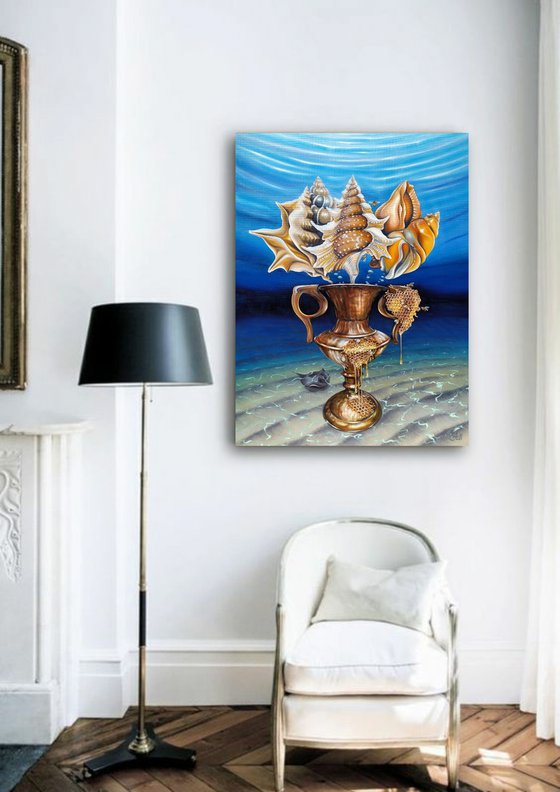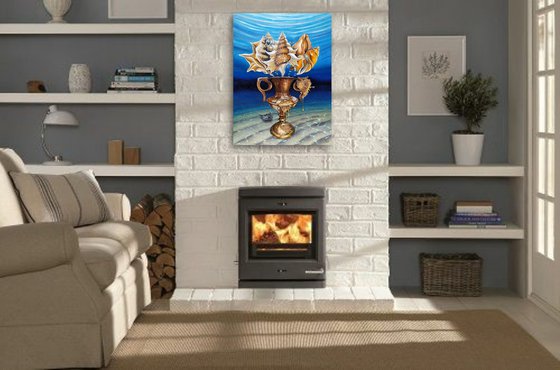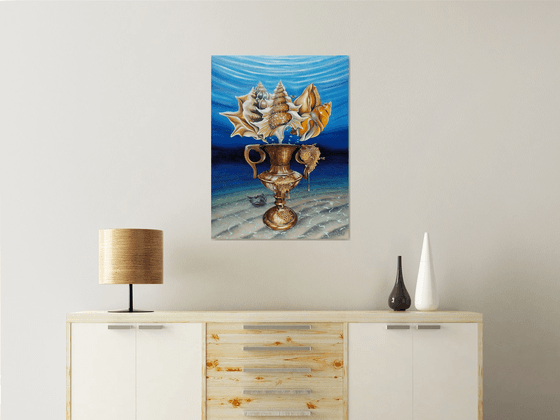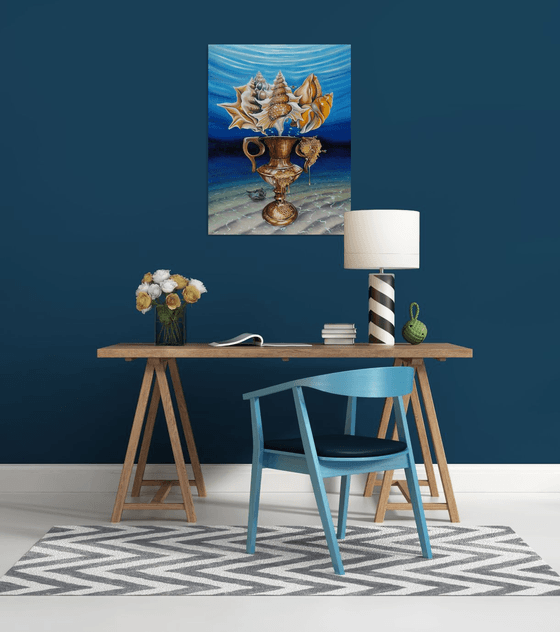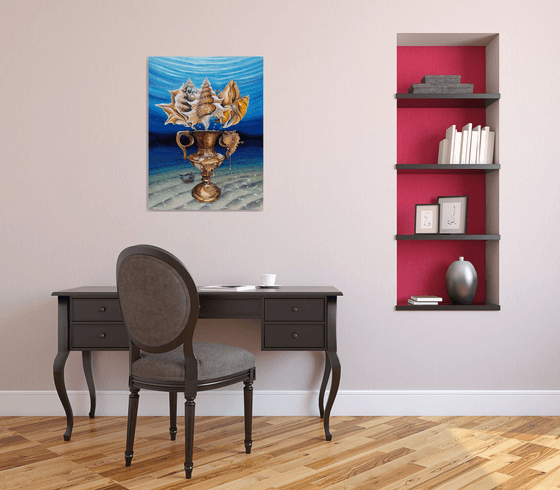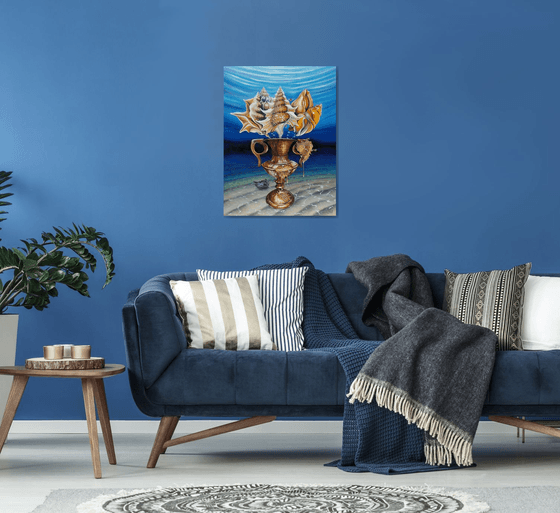Original artwork description:
Have you ever wondered about the importance of shells in nature? Do you think that these are just beautiful toys that were left empty after the death of their owners?
These beautiful toys will be crushed by stones and sand in tidal areas for decades and hundreds of years to come. And in thousands of years the formed powder will form a new rock. The oceans will change their shape, and this rock will get into the soil, and then into plants and flowers. Which, in turn, will fly to pollinate bright, striped hard-working bees.
They will collect pollen from flowers with "sea roots", and then fly to create their wonders of engineering - a mosaic of hexagons, which is especially revered in wildlife. After all, this set of prisms with a regular hexagon at the base is a strict geometric pattern. And this design, without drawings and forecasts, is built by most bees while working and coordinating their attempts to make honeycombs perfect.
At the same time, some marine organisms have well-structured exoskeletons, which also consist of mineral hexagons - they can be called marine honeycombs. And the exoskeleton of bees consists of chitin, as well as the shell of crabs, shrimp and hermit crab.
And when the bees deftly build their perfect honeycombs on the ground and fill it with golden nectar, somewhere on the seabed, the hermit crab will put on a spiral "queen" shell and will show time like a skilled watchmaker, because the spiral turns of the shell, though in different planes and still twist clockwise.
Back in the XIX century. When the German naturalist (and talented artist) Ernst Haeckel first saw these flawless forms, he made them the main decoration of his series of drawings "The Beauty of Forms of Nature", which incredibly influenced artists of the early nineteenth century. and still admirable. For Haeckel, these constructions were proof of the fundamental creativity of nature, its desire for order - it is an uncontrollable impulse of all living things, which invisible thread connects such, at first glance, different worlds. And we can rightly consider this connection wonderful.
Materials used:
Oil
Tags:
#ocean painting #seascape oil painting #sea life #underwater painting #bees #painting for living room #fantasy painting #surrealistic art #picture for bedroom #honey bees #honey #underwater world #seashell painting #bees and flowers painting #honeycombs"The mystery of evolution, or a secret connection" (2021)
Oil painting
by Anna Shabalova
9 Artist Reviews
£2,153.3
- Oil painting on Canvas
- One of a kind artwork
- Size: 60 x 80 x 1.5cm (unframed) / 60 x 80cm (actual image size)
- Ready to hang
- Signed on the front
- Style: Surrealistic
- Subject: Landscapes, sea and sky
Original artwork description
Have you ever wondered about the importance of shells in nature? Do you think that these are just beautiful toys that were left empty after the death of their owners?
These beautiful toys will be crushed by stones and sand in tidal areas for decades and hundreds of years to come. And in thousands of years the formed powder will form a new rock. The oceans will change their shape, and this rock will get into the soil, and then into plants and flowers. Which, in turn, will fly to pollinate bright, striped hard-working bees.
They will collect pollen from flowers with "sea roots", and then fly to create their wonders of engineering - a mosaic of hexagons, which is especially revered in wildlife. After all, this set of prisms with a regular hexagon at the base is a strict geometric pattern. And this design, without drawings and forecasts, is built by most bees while working and coordinating their attempts to make honeycombs perfect.
At the same time, some marine organisms have well-structured exoskeletons, which also consist of mineral hexagons - they can be called marine honeycombs. And the exoskeleton of bees consists of chitin, as well as the shell of crabs, shrimp and hermit crab.
And when the bees deftly build their perfect honeycombs on the ground and fill it with golden nectar, somewhere on the seabed, the hermit crab will put on a spiral "queen" shell and will show time like a skilled watchmaker, because the spiral turns of the shell, though in different planes and still twist clockwise.
Back in the XIX century. When the German naturalist (and talented artist) Ernst Haeckel first saw these flawless forms, he made them the main decoration of his series of drawings "The Beauty of Forms of Nature", which incredibly influenced artists of the early nineteenth century. and still admirable. For Haeckel, these constructions were proof of the fundamental creativity of nature, its desire for order - it is an uncontrollable impulse of all living things, which invisible thread connects such, at first glance, different worlds. And we can rightly consider this connection wonderful.
Materials used:
Oil
Tags:
#ocean painting #seascape oil painting #sea life #underwater painting #bees #painting for living room #fantasy painting #surrealistic art #picture for bedroom #honey bees #honey #underwater world #seashell painting #bees and flowers painting #honeycombsReturns and refunds
We want you to love your art! If you are not completely satisfied with your purchase you can return it free within 14 days, no questions asked. Learn more
Artist Reviews (9)
This artwork is sold by Anna Shabalova from Ukraine


